Introduction
Hey there, fellow gardeners and lawn enthusiasts! We all love the sight of a perfectly manicured lawn, don’t we?
That’s why I’m here today to share some fantastic solutions to help you reclaim your lawn from these furry invaders.
we’ll explore a variety of chemical-free remedies and DIY methods to keep rabbits away from your precious lawn. We’ll start by understanding rabbit behavior and recognizing the signs of infestation.
But that’s not all! We’ll also explore the power of companion planting, where certain herbs and flowers can naturally repel rabbits while adding beauty and fragrance to your garden.
We’ll provide practical tips on how to modify your lawn’s environment, such as removing tall grass, shrubs, and weeds that provide cover for rabbits. We’ll also discuss the importance of regular maintenance and how it can discourage rabbits from taking up residence in your beautiful green space.
Whether you have a sprawling lawn or a small garden, these chemical-free remedies and DIY methods will help you maintain a lush, green oasis without harming those cute little creatures. So get ready to reclaim your lawn and create a harmonious balance with nature.
Now, grab a cup of coffee, put on your gardening gloves, and let’s dive into the wonderful world of chemical-free rabbit control methods. Your beautiful lawn will thank you for it!

Key Takeaways
- Rabbits can cause significant damage to lawns and gardens by grazing on plants and leaving behind droppings.
- Understanding rabbit behavior and recognizing signs of infestation is crucial for effective control.
- Non-toxic remedies include fencing, natural barriers, and repellents like predator urine, strong odors, and human hair.
- Companion planting with marigolds, lavender, and rosemary can deter rabbits while adding beauty.
- Motion-activated sprinklers startle and scare away rabbits from entering your lawn.
- Maintaining a well-maintained lawn, removing tall grass and weeds, can discourage rabbits from taking up residence.
- Electronic repellent devices, such as ultrasonic devices, motion-activated sprinklers, flashing lights, and electronic fencing, can be effective at deterring rabbits.
- Using non-toxic repellents like garlic and pepper spray, coffee grounds, and repellent plants can help protect lawns from rabbit damage.
- Identifying rabbit damage early and implementing preventative measures such as physical barriers and habitat modifications is essential.
- Combining multiple methods and techniques can provide the best protection against rabbits in lawns and gardens.
Chemical-Free Remedies for Rabbit Infestations in Lawns

Rabbits are adorable creatures, but when they start invading our lawns and gardens, they can quickly become a nuisance. While some people resort to harsh chemical solutions to get rid of these furry intruders, there are alternative methods that are both effective and environmentally-friendly.
Understanding Rabbit Behavior and Signs of Infestation
Before we look into the remedies, it’s essential to understand rabbit behavior and recognize the signs of a rabbit infestation. By knowing what to look for, you can take immediate action to protect your lawn.
- Rabbit Behavior
- Rabbits are most active during the early morning and evening hours.
- They tend to graze on lawns, gardens, and tender plants.
- Rabbits create burrows or dig small holes for shelter.
- They leave behind small, round droppings.
- Signs of Infestation
- Chewed plants and vegetation.
- Tracks or pathways through lawns and gardens.
- Damage to flowers, vegetables, or shrubs.
- Droppings scattered around the lawn.
Now that we understand their behavior and signs of infestation, let’s explore natural methods to keep rabbits at bay.
1. Fencing
Installing a fence around your lawn or garden is a highly effective way to deter rabbits.
- Use a mesh or chicken wire to create a fence at least two feet high.
- Bury the bottom of the fence at least 6 inches deep to prevent rabbits from digging underneath.
- Ensure the fence is tight against the ground to prevent rabbits from squeezing through.
2. Natural Barriers
Creating natural barriers can help protect vulnerable areas of your lawn and discourage rabbits from entering.
- Place prickly plants, such as rose bushes or holly, around garden perimeters.
- Install thorny branches or brush piles to obstruct rabbit access points.
- Spread gravel or small stones around plants to make it uncomfortable for rabbits to hop around.
3. Repellents
Using natural repellents can deter rabbits from feasting on your precious plants.
- Predator urine: Purchase predator urine granules (such as coyote urine) and sprinkle it around the garden to create the illusion of a predator presence.
- Strong odors: Rabbits dislike strong smells, so consider using natural deterrents such as garlic, onions, or pepper flakes around gardens or entry points.
- Blood meal: Sprinkle blood meal, a dried animal blood product available at garden centers, around vulnerable plants to discourage rabbits from eating them.
- Human hair: Collect human hair (from your hairbrush or a salon) and scatter it around the garden. The scent of humans can deter rabbits from approaching.
4. Companion Planting
By strategically planting certain herbs and flowers, you can repel rabbits and protect your lawn.
- Marigolds: Plant marigolds in your garden as rabbits dislike their strong smell.
- Lavender: The scent of lavender can deter rabbits, so consider planting it around your lawn and garden.
- Rosemary: Planting rosemary around your lawn or garden provides great fragrance while repelling rabbits.
5. Motion-Activated Sprinklers
Motion-activated sprinklers are an excellent way to startle and deter rabbits from visiting your lawn and garden.
- Install motion-activated sprinklers near your vulnerable plant areas.
- When the sensor detects movement, the sprinklers will activate, squirting water and scaring away the rabbits.
6. Physical Deterrents
Providing physical deterrents can help deter rabbits from entering specific areas.
- Place garden netting or chicken wire over vulnerable plants to create a barrier.
- Use scarecrows or wind chimes in your garden to create movement and noise, which can deter rabbits.
7. Habitat Modification
By modifying your lawn’s environment, you can make it less appealing to rabbits.
- Remove tall grass, shrubs, and weeds that provide cover for rabbits.
- Trim low branches or plants to reduce potential hiding spots.
- Keep your lawn well-maintained to discourage rabbits from taking up residence.
Remember, it’s important to regularly monitor and adapt your control methods to keep rabbits away from your lawn. Combine a few of these remedies for maximum effectiveness.
Effective DIY Methods to Keep Rabbits Away from Your Lawn

Having a lush and well-maintained lawn can be a source of pride for any homeowner. However, when rabbits start invading your green space and wreaking havoc on your plants, it can quickly become a frustrating and challenging situation.
I will share with you some effective DIY methods to keep rabbits away from your lawn, allowing you to enjoy your beautiful garden in peace.
Understanding the Rabbit Problem
Before jumping into the solutions, it’s important to understand why rabbits find your lawn so appealing. Rabbits are primarily attracted to lawns because of the rich variety of plants and vegetation they offer.
To keep rabbits at bay, we need to address their attraction to your lawn.
1. Fencing – Creating a Rabbit Barrier
One of the most foolproof methods to deter rabbits from entering your lawn is to install a sturdy fence. A fence acts as a physical barrier, preventing rabbits from accessing your precious plants.
2. Natural Repellents – Herbal Shields
Rabbits have a sensitive sense of smell, and certain odors can effectively repel them from your lawn. Here are some natural repellents you can try:
- Predator Urine: Place predator urine, such as coyote or fox urine, around your lawn’s perimeter. This scent will discourage rabbits from approaching, as they will perceive a potential danger nearby.
- Spicy Scents: Rabbits also dislike strong and spicy scents. Sprinkle chili powder or garlic powder around your plants or create a homemade spray by mixing chili flakes with water and a few drops of dish soap. Spray this solution on the leaves and stems of your plants to deter rabbits from nibbling.
- Herbs: Certain herbs have a strong aroma that rabbits find unappealing. Planting herbs like sage, oregano, or rosemary around your lawn can act as a natural deterrent.
3. Motion-Activated Devices – Startle and Scare Away
Rabbits are skittish creatures and can easily be frightened. Utilizing motion-activated devices can help startle rabbits and make them think twice before entering your lawn.
- Ultrasonic Devices: These devices emit ultrasonic sound waves that humans can’t hear but are highly effective at repelling rabbits. Place them strategically around your lawn to keep rabbits at a distance.
- Water Sprinklers: Motion-activated sprinklers provide an unexpected splash, scaring off any unwelcome visitors. Set up the sprinkler in areas where rabbits frequently enter your lawn, and watch them scamper away at the first spray.
4. Rabbit-Resistant Plants – Creating a Less Attractive Environment
Instead of trying to repel rabbits, another approach is to make your lawn less appealing to them. Here are some rabbit-resistant plants to consider:
- Marigolds: These vibrant flowers not only add color to your garden but also possess a strong scent that repels rabbits.
- Lavender: Known for its calming fragrance, lavender is also a natural deterrent for rabbits. Plant it near vulnerable areas of your lawn.
- Lamb’s Ear: The soft, fuzzy leaves of lamb’s ear make it unappetizing for rabbits. Consider planting it along the edges of your lawn.
5. Proper Garden Maintenance – Discourage Rabbit Activity
Maintaining your lawn properly goes a long way in deterring rabbits. By following these garden maintenance practices, you can make your lawn less attractive to rabbits:
- Regular Mowing: Keeping your lawn short and well-maintained reduces hiding places for rabbits and discourages their activity.
- Eliminating Weeds: Weeds can provide a tempting food source for rabbits. Regularly inspect your lawn and remove any weeds promptly.
- Clean and Tidy Garden: Fallen leaves, brush piles, and clutter in your garden serve as hiding spots for rabbits. Keep your garden tidy to deter their presence.
6. Homemade Rabbit Repellent – DIY Spray
If you prefer a homemade solution, here’s a simple DIY rabbit repellent spray recipe:
- Gather the following ingredients:
- 1 tablespoon of dish soap
- 1 tablespoon of castor oil
- 1 quart of water
- Mix the ingredients together in a spray bottle.
- Spray the mixture onto plants, leaves, and other vulnerable areas of your lawn.
This homemade spray will make your plants less appealing to rabbits, discouraging their grazing.
7. Professional Help – When DIY Isn’t Enough
Sometimes, despite your best efforts, rabbits persist in invading your lawn. In such cases, it may be prudent to seek professional assistance.
Dealing with rabbit invasions in your lawn may seem like an uphill battle, but with the right methods and a little patience, you can successfully protect your garden from these furry critters. By implementing these DIY techniques, you’ll create an environment that discourages rabbits from making your lawn their personal dining area.
Exploring Electronic Repellent Devices for Rabbit Control
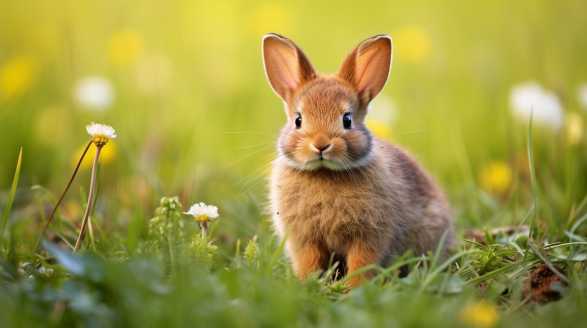
As someone who has experienced the frustration of dealing with rabbit infestations in my garden, I have always been on the lookout for effective and humane methods of rabbit control. One method that has caught my attention is the use of electronic repellent devices.
Understanding Rabbit Infestations
Before we look into electronic repellent devices, it is essential to grasp the havoc rabbit infestations can wreak in gardens. Rabbits are notorious for their voracious appetites, often causing damage to plants, flowers, and even trees.
Traditional methods of rabbit control, such as trapping or fencing, can be time-consuming, costly, and require ongoing maintenance. Hence, the exploration of electronic repellent devices could offer a more efficient solution.
Factors to Consider in Rabbit Control
When considering electronic repellent devices for rabbit control, several factors need to be taken into account. These include the size of the area to be protected, the type of environment (open field or enclosed area), and the life cycle of the rabbits.
Hence, electronic repellent devices may not be suitable for every situation, and a thorough assessment is necessary before implementing them.
Types of Electronic Repellent Devices
When it comes to electronic repellent devices, there are various types available, each with its own unique features and methodologies. Here are a few popular ones:
1. Ultrasonic Repellents
Ultrasonic repellents emit high-frequency sound waves that are inaudible to humans but distressing to rabbits. These devices typically have adjustable frequency settings, allowing users to modify the sound according to the specific situation.
2. Motion-Activated Sprinklers
Motion-activated sprinklers are another effective means of electronic rabbit control. These devices utilize a combination of motion sensors and water sprinklers to startle rabbits and deter them from entering the protected area.
3. Flashing Lights
Rabbits are easily alarmed by sudden movements, making flashing lights an increasingly popular method of electronic repellent. These devices feature bright LED lights that flash sporadically, effectively startling rabbits and discouraging them from approaching the protected area.
4. Electronic Fencing
For individuals dealing with larger areas or widespread rabbit infestations, electronic fencing can be a viable solution. These fences are equipped with wires that emit a mild electric shock when touched by rabbits, providing an effective deterrent without causing harm.
Benefits of Electronic Repellent Devices
Electronic repellent devices offer numerous advantages over traditional rabbit control methods. Here are a few notable benefits:
1. Humane and Environmentally Friendly
Unlike traps or poisons, electronic repellent devices provide a humane and environmentally friendly solution for managing rabbit populations. These devices do not harm or kill rabbits but merely deter them from entering protected areas.
2. Cost-Effective
While the initial investment in electronic repellent devices may be higher than traditional methods, they often prove to be more cost-effective in the long run. Since electronic repellents provide a proactive solution, they can significantly reduce ongoing maintenance costs associated with trapping or fencing.
3. Versatility
Electronic repellent devices offer versatility in terms of usage and adaptability to different situations. Whether you have a small backyard garden or a large agricultural area, there are electronic repellents suitable for every scenario.
4. Ease of Installation and Maintenance
Installing and maintaining electronic repellent devices is generally straightforward. Most devices come with user-friendly interfaces, clear instructions, and simple mounting mechanisms.
5. Continuous Effectiveness
Unlike traps, which require constant monitoring and resetting, electronic repellent devices provide continuous protection. Once installed, these devices act as a deterrent 24/7, reducing the likelihood of damage caused by rabbits.
6. Flexibility
Electronic repellent devices are adaptable and can be used alongside other control methods for optimal results. For example, combining motion-activated sprinklers with ultrasonic repellents can create a multi-layered approach that targets different rabbit behaviors and preferences.
Exploring electronic repellent devices for rabbit control opens new doors for gardeners, farmers, and homeowners seeking a humane and efficient solution. Ultrasonic repellents, motion-activated sprinklers, flashing lights, and electronic fencing are just a few examples of the wide array of devices available.
By harnessing the power of technology, we can ensure the protection of our gardens, crops, and landscapes while respecting the ecosystems in which rabbits play a role.
Natural Ways to Deter Rabbits from Your Lawn

As a homeowner, I have faced my fair share of challenges when it comes to maintaining a beautiful lawn. One particular problem I encountered was keeping pesky rabbits from wreaking havoc on my carefully manicured landscape.
I will share my knowledge and experience with you, presenting a variety of effective methods to keep rabbits at bay.
Understanding Rabbit Behavior
Before we look into the natural deterrents, it’s important to understand a few key aspects of rabbit behavior. Rabbits are herbivores, meaning their diet consists mainly of plant material.
Additionally, rabbits prefer areas with adequate cover, such as shrubs, tall grass, or dense foliage, where they can hide from predators.
1. Create Physical Barriers
One of the most effective ways to prevent rabbits from invading your lawn is by erecting physical barriers. These obstacles create a boundary that rabbits find difficult to breach.
- Install a wire fence: Surround your lawn or garden with a sturdy wire fence, burying it at least six inches deep to prevent rabbits from digging under. Make sure the fence is at least three feet high to discourage them from jumping over it.
- Use chicken wire: If you don’t want to fence off your entire lawn, consider using chicken wire to protect specific areas or plants. Cut the wire into small pieces and loosely lay it over the ground around vulnerable plants. This will make it uncomfortable for rabbits to hop on.
2. Utilize Natural Repellents
There are various natural substances that rabbits find unappealing, and utilizing them as repellents can help deter these creatures effectively. Here are some natural repellents you can try:
- Cayenne pepper: Sprinkle cayenne pepper around the perimeter of your lawn or on specific plants. The strong scent and taste are typically disliked by rabbits, discouraging them from entering the area.
- Garlic and onions: Rabbits also dislike the strong odor of garlic and onions. Mix crushed garlic or onion with water and spray the mixture on plants or directly on the ground to create a deterrent.
3. Plant Rabbit-Resistant Species
Another effective way to discourage rabbits from grazing on your lawn is by planting species they find unappealing. By strategically incorporating these plants into your landscape, you can deter rabbits naturally.
- Marigolds: These vibrant flowers not only add beauty to your landscape but also repel rabbits with their strong scent.
- Lavender: Known for its aromatic properties, lavender is a natural deterrent for rabbits.
- Catnip: Contrary to its appeal to cats, catnip is likely to drive rabbits away, making it an excellent addition to your garden.
4. Adjust Your Lawn Care Routine
By modifying your lawn care routine, you can make your yard less attractive to rabbits. Here are some practices to consider:
- Taller grass: Allow your grass to grow slightly taller than usual. This creates a less desirable habitat for rabbits, as it lacks the openness they prefer.
- Regularly mow and rake: Keep your lawn well-maintained by mowing it regularly and raking up any fallen plant material. This eliminates potential hiding spots for rabbits.
5. Encourage Natural Predators
Introducing natural predators to your yard can help establish a balance in the ecosystem, keeping rabbits from becoming a persistent nuisance. Here are some ways to encourage natural predators:
- Attract birds of prey: Install birdhouses or nesting boxes to attract birds of prey like hawks or owls, which feed on rabbits.
- Invite snakes: Creating a welcoming habitat for non-venomous snakes can help control the rabbit population. Remove any potential threats that might harm the snakes, such as chemical pesticides.
While rabbits can be challenging to deter, implementing a combination of these natural methods can significantly reduce their impact on your lawn. Remember to be consistent with your chosen strategies, as persistence is key when dealing with these persistent creatures.
Hey there, fellow lawn enthusiasts! If you’re anything like me, you take great pride in maintaining a beautiful and vibrant lawn.
These adorable yet mischievous critters can wreak havoc on our lawns, leaving behind unsightly damage. But fret not!
So, let’s hop right into it!
Understanding Rabbit Behavior
Before we dive into the tips, it’s important to understand why rabbits are attracted to our lawns in the first place. These fluffy-tailed creatures are herbivores, meaning they primarily feed on plants, grasses, and tender shoots.
Identify Rabbit Damage
To minimize rabbit damage, it’s essential to identify the signs indicating their presence in your lawn. Here are a few telltale signs to look out for:
- Uneven lawn appearance: Rabbits tend to graze selectively, leading to patches of shorter grass.
- Bite marks: Look for bite marks along the edges of leaves and vegetation.
- Nesting holes: These holes are typically shallow and around four inches in diameter.
- Scattered droppings: Rabbit droppings resemble small, round pellets and are scattered all over the lawn.
Rabbit-Resistant Plants
Choosing rabbit-resistant plants is an effective way to discourage these hoppy intruders from entering your lawn. While no plant is entirely foolproof, some varieties are less appealing to rabbits due to their taste or texture.
- Lavender
- Marigolds
- Rosemary
- Catmint
- Daffodils
Fencing and Barriers
Install a Fence
One of the most effective ways to keep rabbits out of your lawn is to install a rabbit-proof fence. A fence with small gaps, around one inch in diameter, is typically sufficient.
- Buried fencing: Bury the bottom of the fence at least six inches into the ground to prevent rabbits from digging underneath.
- Height considerations: Ensure the fence is at least two feet high to deter rabbits from jumping over.
- Secure gate: Make sure to install a secure gate that rabbits cannot squeeze through or open.
Barriers for Individual Plants
For particularly vulnerable or prized plants, individual barriers can be used instead of a full fence. Consider using the following barriers:
- Chicken wire: Enclose plants with chicken wire or mesh, ensuring it is securely attached to the ground.
- Netting: Stretch netting over plants to protect them from rabbit nibbles.
Natural Deterrents
Strong-Smelling Plants
Rabbits have a keen sense of smell, and certain plants emit odors that repel them. Consider planting the following strong-smelling plants around your lawn:
- Tulips: The pungent smell of tulips is known to deter rabbits.
- Onions and Garlic: The strong odor emitted by these kitchen essentials can help keep rabbits at bay.
- Mint: The refreshing scent of mint can act as a natural deterrent.
Homemade Repellents
Crafting homemade repellents is another fantastic way to deter rabbits from munching on your lawn. Here are a couple of DIY recipes:
- Spicy Spray: Mix water, cayenne pepper, and a few drops of dish soap in a spray bottle. Apply the mixture to plants and vegetation.
- Garlic Solution: Crush garlic cloves and steep them in hot water. Once cooled, strain the solution and spray it on susceptible plants.
Create a Less Attractive Environment
Rabbits are more likely to visit lawns that provide an ideal habitat. By making your lawn less attractive to rabbits, you reduce the chances of them taking up residence.
- Remove hiding spots: Clear away brush piles, leaf piles, and tall grass, as these provide ideal hiding spots for rabbits.
- Keep it tidy: Regularly mow your lawn and trim overgrown vegetation to make it less appealing to rabbits.
- Reduce water sources: Rabbits need water to survive, so fixing leaky hoses or reducing water sources in your yard can discourage their visitation.
Congratulations, my lawn-loving friends! With these lawn care tips, you are now armed with valuable knowledge to minimize rabbit attraction and the damage they may cause.
So, let’s get out there and keep those mischievous bunnies at bay! Here’s to a lush, vibrant, and rabbit-free expanse of green!
Utilizing Motion-Activated Sprinklers to Scare Off Rabbits

As an avid gardener and homeowner, I understand the frustrations that can come with rabbits nibbling away at your plants and flowers. I have spent countless hours researching and experimenting with various methods to keep these pesky critters away from my garden.
I will share everything I know about this topic and provide you with some useful insights on how to scare off rabbits from your garden using motion-activated sprinklers.
Understanding the Rabbit Problem
Before we dive into the solution, it’s important to understand why rabbits can be such a nuisance in your garden. These small mammals are herbivores, meaning their diet primarily consists of vegetation.
While rabbits may seem harmless at first, their feeding can quickly wreak havoc on your carefully manicured lawn and beloved plants.
The Advantages of Motion-Activated Sprinklers
Motion-activated sprinklers provide a clever and environmentally friendly solution to repel rabbits from your garden. Here are some advantages of using these sprinklers:
- Effective Deterrent: Motion-activated sprinklers are designed to startle animals and scare them away. The sudden burst of water acts as a deterrent and is an effective way to teach rabbits to avoid your garden.
- Humane Approach: Unlike other methods such as traps or chemical deterrents, motion-activated sprinklers offer a humane approach to rabbit control. The sprays of water do not harm the animals in any way, only surprising them and teaching them to stay away.
- Safe for Plants: Motion-activated sprinklers are safe to use around your beloved plants and flowers. Unlike some chemical repellents, there is no risk of harming your garden in the process.
- 24/7 Protection: Motion-activated sprinklers operate day and night, providing round-the-clock protection for your garden. Even when you’re not around, they will continue to deter rabbits and keep them from destroying your plants.
How Motion-Activated Sprinklers Work
Motion-activated sprinklers are equipped with built-in sensors that detect movement within a specified range. Once triggered, the sprinklers release a burst of water for a predetermined period of time.
- Placement is Key: To maximize the effectiveness of motion-activated sprinklers, proper placement is crucial. Determine the areas of your garden that rabbits frequently target and position the sprinklers to cover those spots. Be sure to adjust the motion sensitivity and spray range according to your garden’s needs.
- Sensor Sensitivity: Most motion-activated sprinklers allow you to adjust the sensor sensitivity, allowing you to fine-tune the detection range. It’s important to strike a balance so that the sprinkler is triggered by rabbits, but not by passing birds or other harmless wildlife.
- Water Conservation: Some motion-activated sprinklers have adjustable spray settings, allowing you to conserve water while still effectively deterring rabbits. Opt for a more narrow spray pattern to minimize water usage while ensuring the desired coverage.
Tips for Maximum Effectiveness
While motion-activated sprinklers alone can work wonders in keeping rabbits away from your garden, here are a few additional tips that can further enhance their effectiveness:
- Regularly Move the Sprinklers: Rabbits can become accustomed to the presence of sprinklers if they remain in the same location for an extended period of time. Move the sprinklers around your garden every few days to keep the rabbits on their toes and prevent them from adapting to the deterrent.
- Combine with Other Methods: For particularly persistent rabbits, combining the use of motion-activated sprinklers with other deterrent methods can be highly effective. Consider utilizing various repellents, barriers, or even planting rabbit-resistant plants to create a multi-layered defense system.
- Consistency is Key: To successfully deter rabbits, it’s important to maintain consistency in using motion-activated sprinklers. Keep them operational throughout the growing season and even during the winter months if rabbits remain active in your area. Consistency will reinforce the message and help establish your garden as a no-go zone for rabbits.
Utilizing motion-activated sprinklers is an excellent way to scare off rabbits and keep your garden safe from their voracious appetites. It provides an effective, humane, and environmentally friendly solution to the rabbit problem.
So take control of your garden and let motion-activated sprinklers do the job of repelling rabbits, ensuring your plants and flowers remain untouched and thrive throughout the year.
How to Spot Rabbit Damage and Prevent Further Destruction

Rabbits may look cute and harmless, but they can wreak havoc on our gardens and landscape if left unchecked. As a passionate gardener, I have had my fair share of frustrations dealing with rabbit damage.
I will share my experiences and knowledge on identifying rabbit damage, as well as effective prevention strategies. By following these tips, you can reclaim your garden and protect it from these mischievous nibblers.
Identifying Rabbit Damage
Rabbits are notorious for their love of munching on leafy greens and young plant shoots. Identifying the signs of rabbit damage early can help you take immediate action to protect susceptible plants.
- Nibbled leaves: Examine the edges of leaves and foliage. Rabbits typically leave a clean, angled cut about 45 degrees from the ground. Unlike deer or other pests, rabbits usually don’t eat the stems or fruits.
- Small circular droppings: Rabbit droppings resemble small, round pellets, about the size of a pea. They are often scattered near feeding areas or along the pathways.
- Gnawed bark: Look for signs of gnawing on young tree trunks or branches. Rabbits have a strong gnawing instinct, particularly during the winter months when food is scarce.
- Bare patches in lawns or garden beds: Rabbits may create barren patches by systematically grazing on grass and plant shoots. These areas may appear as neatly manicured patches devoid of vegetation.
Plants Prone to Rabbit Damage
While rabbits are generally opportunistic eaters, there are certain plants they find particularly irresistible. Here are some commonly targeted plants:
Vegetables
- Lettuce
- Spinach
- Carrots
- Beans
- Peas
Ornamental Plants
- Hostas
- Petunias
- Hydrangeas
- Azaleas
- Impatiens
Identifying these vulnerable plants in your garden can help you focus on protecting them from rabbit damage.
Preventing Rabbit Damage
Now that you can spot rabbit damage, it’s time to take preventative measures to protect your beloved plants. These strategies will help repel rabbits and discourage them from causing further destruction:
1. Install Physical Barriers
One of the most effective ways to prevent rabbit damage is to create a physical barrier. Here are some options to consider:
- Wire mesh: Install a wire mesh fence around your garden or individual plants. Bury the fence at least 6 inches deep to prevent rabbits from burrowing under it.
- Chicken wire cages: Construct cages using chicken wire to protect vulnerable plants. Ensure the cage extends above the height rabbits can reach when standing on their hind legs.
- Tree guards: Wrap tree trunks and young saplings with mesh or plastic tree guards to safeguard them from gnawing rabbits.
2. Use Repellents
Repellents can be effective in deterring rabbits, making your garden less inviting. Consider the following options:
- Liquid repellents: Spray liquid repellents, like hot pepper spray or predator urine, on plants to make them less appealing to rabbits.
- Granular repellents: Spread granular repellents around your garden, focusing on areas where rabbits are active. These contain foul-smelling ingredients that deter rabbits.
- Natural deterrents: Create homemade deterrents by placing strong-smelling substances near vulnerable plants, such as garlic cloves, onion slices, or human hair.
3. Modify the Habitat
Making your garden less attractive to rabbits can reduce the chances of damage. Try the following habitat modifications:
- Remove cover: Clear away brush piles, tall grass, and other potential hiding spots near your garden. Rabbits are less likely to frequent areas without protective cover.
- Trim vegetation: Keep grass and weeds trimmed around your garden. By reducing available food sources, you can discourage rabbits from venturing into your yard.
- Fence off vulnerable areas: If you have specific areas you want to protect, consider installing fences around them. This ensures rabbits cannot access those sections.
Rabbit damage can be frustrating, but by learning how to spot rabbit damage early and implementing preventative measures, you can effectively protect your plants. Use the techniques discussed in this article to identify signs of rabbit damage, focus on vulnerable plants, and prevent further destruction.
Remember, rabbits are resourceful creatures, so it may take a combination of techniques to keep them at bay. Stay vigilant, adapt your strategies as needed, and enjoy your beautiful, rabbit-free garden.
Exploring Non-Toxic Repellents to Protect Your Lawn from Rabbits
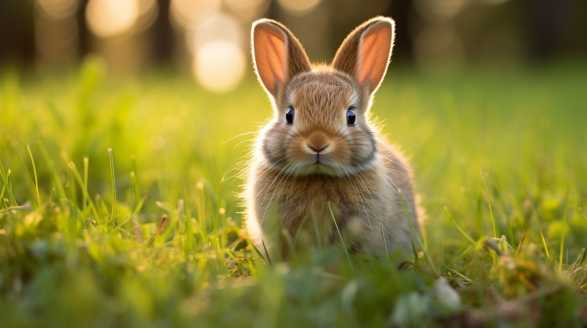
As a homeowner and gardening enthusiast, I always strive to maintain a beautiful and pristine lawn. However, dealing with pesky rabbits that continuously wreak havoc on my hard work can be quite frustrating.
Today, I want to share with you some non-toxic repellent options that have proven to be effective in keeping rabbits at bay.
Understanding the Need for Non-Toxic Repellents
Before delving into the different repellent options, it is essential to acknowledge the importance of using non-toxic methods to control rabbit damage. Rabbits are creatures that coexist with nature, and using harmful chemicals to deter them can have adverse effects on the environment and other wildlife.
By incorporating non-toxic repellents into your lawn protection strategy, you not only ensure the safety of your furry friends but also maintain a healthy ecosystem around your home.
1. Garlic and Pepper Spray
One of the simplest and most effective non-toxic repellents for rabbits is a homemade garlic and pepper spray. Rabbits have a strong sense of smell, and this spray acts as a powerful deterrent.
To make your own garlic and pepper spray, follow these steps:
- Finely chop four cloves of garlic and one hot pepper.
- Boil the chopped ingredients in a quart of water for twenty minutes.
- Allow the mixture to cool, then strain it into a spray bottle.
- Spray the solution generously around areas where rabbits frequent in your lawn.
2. Coffee Grounds
Believe it or not, coffee grounds not only make an excellent fertilizer but also work wonders as a rabbit repellent. Rabbits dislike the strong smell of coffee, making it an ideal option for protecting your lawn.
To use coffee grounds as a repellent:
- Save your coffee grounds after brewing.
- Spread a thick layer of coffee grounds around plants or areas vulnerable to rabbit damage.
- Replenish the coffee grounds regularly, especially after rain.
3. Plants Rabbits Dislike
Certain plants are less appealing to rabbits due to their specific smells, textures, or tastes. Consider adding these rabbit-resistant plants to your lawn:
- Lavender
- Marigolds
- Sage
- Catnip
The strong scents of these plants can confuse rabbits, making them less likely to venture into your lawn. Additionally, incorporating these plants into your garden adds a touch of beauty and fragrance.
4. Fencing
If you’re looking for a more effective physical barrier, fencing can be an excellent option. Rabbits are excellent jumpers, so it is crucial to choose a fence that is at least two feet high to discourage their entry into your lawn.
Consider these factors when installing a fence:
- Choose a sturdy material such as chicken wire or welded wire mesh.
- Bury the fence at least six inches into the ground to prevent rabbits from digging underneath.
- Double-check for any gaps or holes that could allow rabbits to squeeze through.
5. Repellent Plants
Rabbits have a sensitive palate and tend to avoid plants with strong aromas or tastes that they find unappetizing. Consider including these plants in your lawn to act as natural repellents:
- Mint
- Thyme
- Oregano
- Yarrow
These plants serve a dual purpose by not only repelling rabbits but also enhancing the aesthetic appeal of your lawn. Plus, they can be a delightful addition to your culinary adventures!
6. Homemade Repellent Balls
Another inventive way to deter rabbits from your lawn is by creating homemade repellent balls. These balls are infused with strong-smelling natural ingredients that rabbits find unpleasant.
Here’s how you can make your own repellent balls:
- Mix together equal parts dried blood meal, powdered garlic, and laundry starch.
- Slowly add clean water, a little at a time, until the mixture becomes a thick paste.
- Roll the mixture into small balls.
- Leave the balls to dry for a day or two.
- Place the dried repellent balls strategically around your lawn to deter rabbits.
Protecting your lawn from rabbits can be a challenging task, but it doesn’t necessarily require the use of harmful chemicals or pesticides. Non-toxic repellents offer a safer and more sustainable solution to ensure the well-being of both your garden and local ecosystem.
By incorporating garlic and pepper spray, coffee grounds, rabbit-resistant plants, physical barriers like fencing, repellent plants, or homemade repellent balls, you can effectively deter rabbits and maintain a beautiful, rabbit-free lawn. So go ahead, explore these non-toxic options, and enjoy the benefits of a vibrant and flourishing outdoor space!
Conclusion
In conclusion, fellow gardeners, I hope you’ve found these non-toxic remedies and DIY methods for deterring rabbits from your lawn as helpful as I have. Dealing with rabbit invasions can be frustrating, but with the knowledge and techniques shared in this article, you can reclaim your beautiful green space and coexist harmoniously with these fluffy critters.
Understanding rabbit behavior and being able to recognize the signs of infestation is crucial for effective control. By implementing fencing, natural barriers, and repellents like predator urine, strong odors, and human hair, you can create a barrier and deter rabbits from feasting on your precious plants.
Motion-activated sprinklers startle and scare away rabbits, allowing you to protect your lawn without harming them. Combine this high-tech approach with physical deterrents like garden netting or scarecrows to create multiple layers of defense against rabbit invasion.
Modifying your lawn’s environment by removing tall grass, shrubs, and weeds that provide cover for rabbits can also discourage them from taking up residence. And remember, regular maintenance is essential in deterring rabbits from making your lawn their home.
Electronic repellent devices offer a high-tech solution, with options such as ultrasonic devices, motion-activated sprinklers, flashing lights, and electronic fencing. These devices, combined with non-toxic repellents like garlic and pepper sprays, coffee grounds, and repellent plants, provide a comprehensive approach to rabbit control in your lawn and garden.
By combining multiple methods and techniques, you can create a harmonious balance between a beautiful lawn and a rabbit-free environment. Remember to be consistent with your chosen strategies and adapt them as needed.
So, fellow gardeners, let’s reclaim our lawns and create a haven of beauty and serenity. With these chemical-free remedies and DIY methods, we can maintain a thriving landscape without harming these adorable creatures.
Happy gardening!
Frequently Asked Questions
How can I stop rabbits from destroying my lawn?
There are several effective strategies you can try to prevent rabbits from destroying your lawn:
- Install a fence: Use wire mesh or chicken wire to create a physical barrier around your lawn. Make sure the fence is buried at least six inches deep to prevent rabbits from burrowing underneath.
- Use repellents: Apply commercial or homemade repellents around the perimeter of your lawn. These can be made from ingredients like garlic, vinegar, and hot peppers, which rabbits find unpleasant.
- Remove attractions: Make your lawn less inviting to rabbits by removing any food sources or hiding spots. Trim tall grass, remove fallen fruits or vegetables, and store garbage securely.
- Plant rabbit-resistant plants: Rabbits tend to avoid plants that have a strong aroma, fuzzy leaves, or thorns. Consider planting flowers like marigolds, lavender, or snapdragons, or shrubs like barberry or spirea.
- Create distractions: Provide alternative food sources to divert rabbits’ attention away from your lawn. Plant a separate patch of clover or other rabbit-friendly plants that they can graze on.
- Use motion-activated devices: Set up motion-activated sprinklers or noise makers to startle rabbits and discourage them from entering your lawn.
- Try natural predators: Introducing natural predators like dogs or cats to your yard can help deter rabbits. However, ensure that these animals are under your control and will not harm other wildlife or become a nuisance themselves.
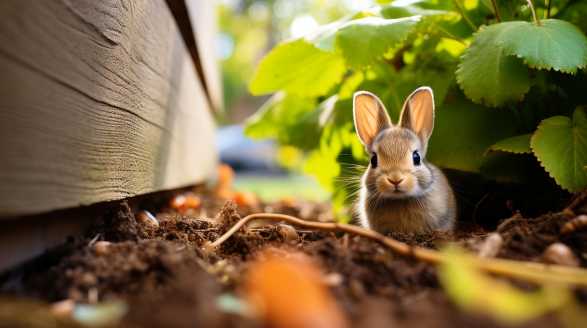
What To Do With Baby Rabbits In Your Yard
Introduction Are you ready to dive into the wonderful world of baby rabbits? Well, you’re in for a treat! Whether you stumbled upon a litter of baby rabbits or are a proud rabbit owner, this guide has got you covered. First things first, we’ll start by understanding the needs of baby rabbits. These cute little […]

Can Rabbits Get Sick
Introduction Hey there, rabbit owners and enthusiasts! Are you ready to dive into the world of rabbit health and care? As a proud rabbit owner myself, I understand the love and concern we have for our furry companions. We want nothing but the best for them, right? we’ll be covering a range of topics related […]

When Do Baby Rabbits Get Fur
Introduction Hey there, fellow rabbit enthusiasts! If you’re like me, there’s nothing more enchanting than watching baby rabbits grow from their hairless, vulnerable state to becoming adorable, furry balls of joy. we’ll take a deep dive into the development of fur in newborn rabbits, exploring their timeline from birth to fluffiness. From the moment they […]
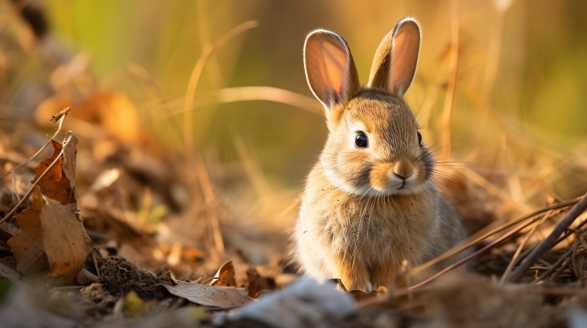
Do Rabbits Have Periods
Introduction Do rabbits have periods? Let’s find out. Get ready to have your curiosity piqued and your mind blown! Picture this: a world where fluffiness meets fertility, where hopping creatures mysteriously navigate their menstrual cycles. As a nature lover and self-proclaimed rabbit connoisseur, I confess that I, too, was initially taken aback by the concept […]

Rabbits In Mythology
Introduction Hey there, fellow adventure-seekers! Get ready for a wild ride as I take you on a journey through the world of rabbits in mythology. So, hop on board as we explore the diverse tales and symbolism surrounding these enigmatic creatures. Picture this: a mystical land filled with gods and goddesses, mischievous tricksters, and chilling […]
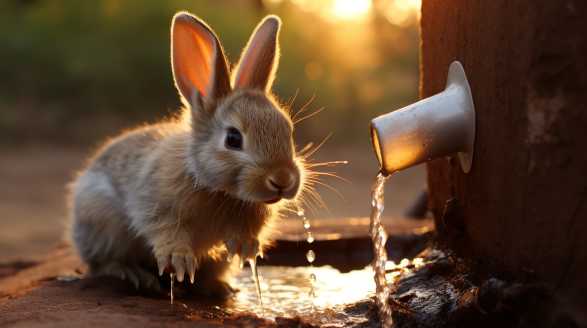
What Do Rabbits Drink
Introduction Are you a rabbit owner looking to make sure your furry friend is getting the best care possible? You’re in the right place! You might already know that rabbits need a balanced diet to stay healthy, but did you know that water is a crucial part of that equation? It’s true! But how much […]
